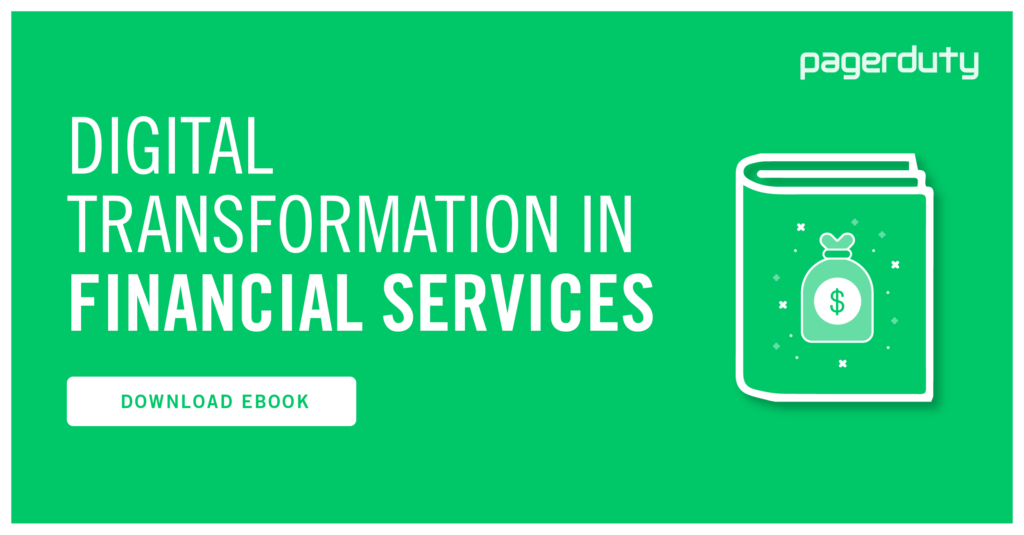- PagerDuty /
- Blog /
- Use Cases & Solutions /
- Modern Banking’s Hurdles in the Technology Race
Blog
Modern Banking’s Hurdles in the Technology Race
With the rise in FinTech startups, increasingly stringent regulations, and changing customer behaviors and expectations, financial institutions need to adapt quickly in order to stay relevant and competitive in today’s market. We recently met with executives from over 15 global banks to learn more about the challenges they face when it comes to embracing digital transformation.
And the challenges are many—the financial services industry must maintain compliance with regulatory requirements and ensure cybersecurity while being flexible enough to meet the demands of customers. And with technology permeating every aspect of our lives, from smart thermometers and connected cars to delivery drones and smart watches, it’s no surprise that consumers are demanding more of their banks as well.
After our meetings, we found many banks wanted to be the first to modernize the financial services industry and drive innovation to enhance the customer experience. They also shared similar concerns, including the reliability of adopted technology, cybersecurity, and visibility into the cloud migration process.
Digital Reliability Is a Must
Today, most customers prefer to do their everyday banking online or on their mobile device rather than visiting a branch and standing in line to talk to a teller—in fact, a recent survey found that nearly 40 percent of Americans manage their bank accounts online while only 18 percent go to a bank branch.
With these numbers, it’s easy to understand why digital reliability is so important. Since banks deal with people’s money, technology failures can seriously harm a bank’s brand. For example, if the website goes down and customers are unable to access their accounts online, they get worried and wind up calling for help, which increases wait times to speak to a customer service representative. The end result? Lost time and a lot of unhappy customers lashing out on social media and/or closing their accounts.
The ripple effect from just one single incident can have a major negative impact to a bank’s bottom line. To help achieve customer service goals and increase customer retention, banks should have an organized incident response process in place to help minimize website and operations downtime.
Cybersecurity: An Ongoing Concern
Cybersecurity continues to be a top concern for banks. In PwC’s 19th Annual Global CEO Survey, 69 percent of FinServ CEOs reported that they are “either somewhat or extremely concerned about cyber threats.”
And no wonder: In February 2016, the central bank of Bangladesh was the victim of a major cyber heist. Five transactions withdrew a total of $101 million ($20 million of which was later recovered). In October 2017, using a similar method as in the Bangladesh heist, hackers stole $60 million from the Far Eastern International Bank in Taiwan.
These are just two of many examples. Add cross-border data exchanges, the increased use of mobile technologies by customers, and IT hiring out software-as-a-service to improve productivity to the mix—all of which make it more difficult to effectively implement perimeter security—and we begin to see why cybersecurity continues to be a top concern for the financial services industry.
The ability to respond quickly to threats can make a huge difference in keeping customer data safe while remaining competitive. For instance, financial institutions already have processes in place to alert their Security Operations (SecOps) teams when unusual activity is detected, but the real value lies in reducing response times and filtering out all the noise. Many security teams get more security alerts than they can look at, so they need a way to filter down and prioritize the ones that are likely to matter most to the business.
Visibility Into the Cloud Migration Process
Just 10 years ago, sending money via international wire transfers meant paying a hefty transfer fee on top of a foreign currency exchange fee—and recipients likely didn’t see the funds until a week later. Friends split bills by handing over cash or writing physical checks that took three to five business days to clear. Many companies still hadn’t implemented direct deposit for their payrolls, which meant employees had to take their paychecks into branches to deposit them after work, then wait until the next day for the funds to be available.
Not anymore. Today, transactions are handled fast—services like TransferWise charge minimum fees and shorten the time from when money is sent to when someone receives it. Apps such as Venmo and Apple Pay Cash have eliminated the need to write physical checks to friends to cover the dinner bill. Paychecks are direct deposited into accounts automatically and funds are available on the same day.
To remain competitive, banks need to be able process transactions as quickly as possible. Customers unable to access their money will understandably get frustrated, which can lead to them switching banks. To keep up with the speed of how customers do their banking, banks are moving some processes into the cloud. But as with any project involving large amounts of sensitive data, a lot of care is required. Bank leaders need visibility into the cloud migration process to ensure transactions stay secure—after all, they are dealing with a lot of sensitive data.
What Banks Can Do
Our discussions with financial services organizations have centered around how to become more agile in the face of the challenges presented here. To help address these challenges, it’s critical that banks respond as quickly as possible to mitigate risk. PagerDuty enables banks to respond quickly to security threats or capitalize on consumer trends, helping to increase customer satisfaction, maximize revenue, and focus on innovation.



